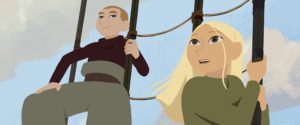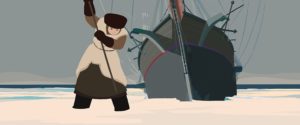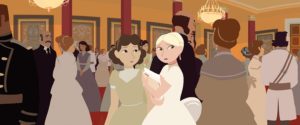 In the animated adventure, Long Way North, an adventurous young aristocrat searches for her explorer grandfather, lost with his Russian icebreaker in the treacherous seas of the Arctic’s northeast passage. From a script by animation teachers Claire Paoletti and Patricia Valeix of La Poudriere animation school, the French-Danish co-production was directed on a small 6.4 million euro budget by Rémi Chayé.
In the animated adventure, Long Way North, an adventurous young aristocrat searches for her explorer grandfather, lost with his Russian icebreaker in the treacherous seas of the Arctic’s northeast passage. From a script by animation teachers Claire Paoletti and Patricia Valeix of La Poudriere animation school, the French-Danish co-production was directed on a small 6.4 million euro budget by Rémi Chayé.
The financial constraints on the film meant that the team had to be efficient and work as quickly as possible. Chayé, who had previously worked in layout and storyboarding, drew most of the storyboards himself and over the course of about ten months completed the animatic, complete with sound. “It was not working,” admitted Chayé. “We had a problem.”
It was at that point that producer Henri Magalon became involved in the project. “I watched the film, and it was beautiful, very beautiful in terms of art direction and camera placement, but the characters were not there, the story was not there,” shared Magalon. To find the root of the problem, he requested a copy of the screenplay and realized it was identical to the animatic. Although the script was well written, he determined that it was a story problem, not an animatic problem.
“It said on the pages that the girl was great, everybody loved her, but Rémi was telling me, ‘Every day I go there and I do not like her.’ She was not likeable,” said Magalon. Chayé added, “She was a needy princess and she had no fight to fight.”
So as to not waste time or money, Magalon advised a rewrite and redo of the animatic before production commenced. With six months to get into production before contracts expired, Magalon signed on to co-produce, bringing money to the table to get the necessary revisions done. The team had “no safety net,” and as they rushed to get back on track, Fabrice de Costil came on as an additional writer.
Since Long Way North was his first film as a director, Chayé wanted to understand the whole feature animation process in  order to establish an efficient pipeline. To that end, while the script was being developed, he worked as an assistant director and storyboard artist on other animated films.
order to establish an efficient pipeline. To that end, while the script was being developed, he worked as an assistant director and storyboard artist on other animated films.
“Because it took so much time to be produced, I had time to invent it,” revealed Chayé. “I was already sure I would have a small budget, so I wanted to create a style and a pipeline that would fit within the budget. That is why I took out all the outlines of the characters so to create a very strong impact with strong lighting, storing colors and no details at all. I have no patterns. I have no lace. Even the faces are very simple. I simplified as much as possible.”
Before the screenwriting was finished, the director worked to find the movie’s graphic style. Chayé likes setting the stage by placement of the objects in each scene. He supervised the black and white layout himself, making all the major decisions before the background artists took the next step of adding color. During the storyboarding, Chayé made decisions on staging and where to place the camera for the best emotional impact. His references were not specifically animation films, but rather live action cinema.
The filmmakers used a number of different tools in production. The film was digital 2D animation, which meant everything was drawn by hand, using a graphic palette that allowed the artists to draw directly on the computer screen, avoiding the step of scanning the art into a computer. Other than the first paper drawings, the production was 100% digital.
“We have to create everything,” explained Chayé. “We did a little bit of 3D to backgrounds to make sure the perspective is right. For example, the cabin of the boat is so small you have to 3D a simple sketch. A 3D model was used to shoot a different angle.”
 Magalon elaborated, “We have all the quality of the classical drawings, but also the computer tools that make it subtle, and fluid. It’s something different from other films I’ve seen. It’s fragile, but still controlled and powerful.”
Magalon elaborated, “We have all the quality of the classical drawings, but also the computer tools that make it subtle, and fluid. It’s something different from other films I’ve seen. It’s fragile, but still controlled and powerful.”
Once the production had a revised script, during the second storyboard stage, the company started bringing on the full crew. The final credits ultimately included 178 people with 90 of those working as artists in the areas of animation, layout and storyboard. After 10 months of working on the project by himself, he relied on the other artists, such as animation director, Han Jin Kuang Liane-Cho, and animator, Mailys Vallade, “to reengage the passion for the story.” Several months later they had a very “convincing animatic.”
Once the animatic was approved, professional voices were brought in to record for three or four days. Chayé knew how to work with artists to get the best from them, but directing the actors was a “bit scary” for him because it was the first time he worked with actors.
The majority of lines in the script that came from the young aristocrat, Sasha, were recorded over an additional three days. Sasha was voiced by actress Christa Théret, because the director felt she had magic in her voice with a touch of fragility. Every time she spoke it was emotionally moving. “It’s like she is about to cry,” stated Chayé. “I really liked her voice.”
The dialog was edited into the animatic in advance of the animation process. Chayé credited Benjamin Massaoubre with not only editing the film, but also contributing to the story, building the intensity to the end of the film.
The animators worked scene-by-scene using the final dialog. Using in Flash, they could advance the audio frame by frame to sync up the voices with the animation. Painter Patrice Suau was the color background artist responsible for the movie’s palette.
Ultimately, the whole crew made the film possible. The company rented a large flat in Paris, and put in forty tables for every one to work in the open space. Every creative discussion was heard by everyone, allowing the information to be easily disseminated.
“It was a very organic way of working,” Chayé said. “It’s teamwork. All of us are important.”
Magalon added, “We’re all willing to do it again. We started a new project. The whole crew, we want them to be back. They all want to be back. We’re trying to do it better if we can with the same people.”





